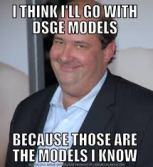From Lars Syll While one can understand that some of the elements in DSGE models seem to appeal to Keynesians at first sight, after closer examination, these models are in fundamental contradiction to Post-Keynesian and even traditional Keynesian thinking. The DSGE model is a model in which output is determined in the labour market as in New Classical models and in which aggregate demand plays only a very secondary role, even in the short run. In addition, given the fundamental philosophical problems presented for the use of DSGE models for policy simulation, namely the fact that a number of parameters used have completely implausible magnitudes and that the degree of freedom for different parameters is so large that DSGE models with fundamentally different parametrization (and
Topics:
Lars Pålsson Syll considers the following as important: Uncategorized
This could be interesting, too:
tom writes The Ukraine war and Europe’s deepening march of folly
Stavros Mavroudeas writes CfP of Marxist Macroeconomic Modelling workgroup – 18th WAPE Forum, Istanbul August 6-8, 2025
Lars Pålsson Syll writes The pretence-of-knowledge syndrome
Dean Baker writes Crypto and Donald Trump’s strategic baseball card reserve
from Lars Syll
While one can understand that some of the elements in DSGE models seem to appeal to Keynesians at first sight, after closer examination, these models are in fundamental contradiction to Post-Keynesian and even traditional Keynesian thinking. The DSGE model is a model in which output is determined in the labour market as in New Classical models and in which aggregate demand plays only a very secondary role, even in the short run.
In addition, given the fundamental philosophical problems presented for the use of DSGE models for policy simulation, namely the fact that a number of parameters used have completely implausible magnitudes and that the degree of freedom for different parameters is so large that DSGE models with fundamentally different parametrization (and therefore different policy conclusions) equally well produce time series which fit the real-world data, it is also very hard to understand why DSGE models have reached such a prominence in economic science in general.
Neither New Classical nor ‘New Keynesian’ microfounded DSGE macro models have helped us foresee, understand or craft solutions to the problems of today’s economies. But still most young academic macroeconomists want to work with DSGE models.
 After reading Dullien’s article, that certainly should be a very worrying confirmation of economics — at least from the point of view of realism and relevance — becoming more and more a waste of time. Why do these young bright guys waste their time and efforts? I think maybe Frank Hahn gave the truest answer when interviewed on the occasion of his 80th birthday, he confessed that some economic assumptions didn’t really say anything about ‘what happens in the world,’ but still had to be considered very good ‘because it allows us to get on this job.’
After reading Dullien’s article, that certainly should be a very worrying confirmation of economics — at least from the point of view of realism and relevance — becoming more and more a waste of time. Why do these young bright guys waste their time and efforts? I think maybe Frank Hahn gave the truest answer when interviewed on the occasion of his 80th birthday, he confessed that some economic assumptions didn’t really say anything about ‘what happens in the world,’ but still had to be considered very good ‘because it allows us to get on this job.’